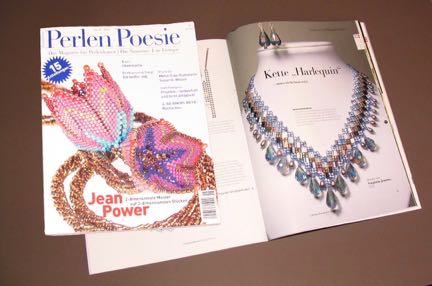by Virginia Jensen
I first became interested in beadwork
because I had moved to a new city and was out of a job.
I ended up working part time at Michaels craft store demonstrating products and holding classes in craft work. The beading teacher was unable to continue, so I said, “ Well, I can do that.”
And I did.
Following a Friend’s Suggestion Led to My First Design Publication
The work fascinated me more than I would have imagined. I soon discovered bead weaving and bead embroidery, which are much more complex and challenging. So I began to generate bead designs as if it were my job.
Soon I had quite a few designs that I had not seen in the books I read. At a local show a friend said, “You should submit that design to ‘Bead and Button Magazine.’”
I hadn’t thought of that, but as soon as I did submit it the design was accepted. Other submissions and publications followed.
Submitting to a Larger Publisher Worked Better for Me
I began working with a new kind of bead that was a cube instead of a round. I thought perhaps others would like some designs to make with these new beads, so I completed enough pieces to make a book proposal.
My first submission to a publisher was simply ignored. After a month I decided to go for the biggest bead book publisher in the U.S., and they accepted my suggestion right away.
After the first book sold well, they suggested I write another.
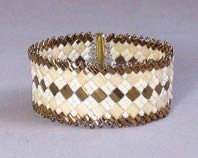
Changes in the Beads Led to New Designs
The third book came about in a similar manner. New beads with two holes became a hot item in the bead market. Of course you can’t use the instructions and stitches for single-hole beads when working with two-hole beads, so new designs and stitching instructions were needed.
My fourth book is more two-hole bead projects, which is timely again because the two-hole beads have burgeoned, and now there are dozens of sizes and shapes, and three- and four-hole beads as well. Endless opportunities await.
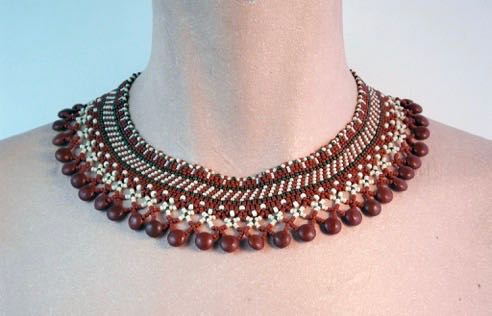
Moving from Graphic Design to Writing a Book was a Challenge
I had great fun doing the creative work, designing and making the pieces, but when it came to creating a book, I was challenged.
I had been a graphic designer for many years so I was quite familiar with book publication and design. But what was needed from me for this book was detailed text and illustration.
Showing someone how to make a thing as complex as a necklace, bracelet or pair of earrings out of tiny beads is a challenge. You must explain exactly what materials are needed, how to use them, where to insert the needle and thread over and over until you have finished the construction, and then show how to pull it all together.
So many steps must be described in detail. And then illustrations or photos are also required. I did the illustrations in Adobe Illustrator, and often more than one illustration was required to contain all the steps for a piece.
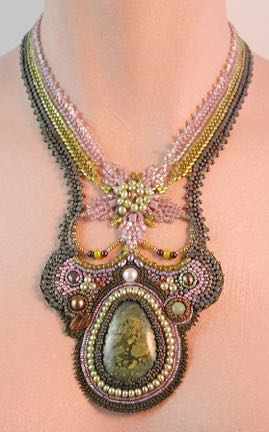
To Finish a Book, Stubbornness and Diligence are Required
I think pulling all the parts and pieces together was hardest. It was required that each of the over 30 pieces in each book be numbered by the publisher’s system, and each section of text and each illustration be numbered to match.
And then all had to be shipped off along with the actual pieces for the publisher to work with and photograph. Stubbornness and diligence were required. But the difficulty was quickly forgotten when the package shipped.
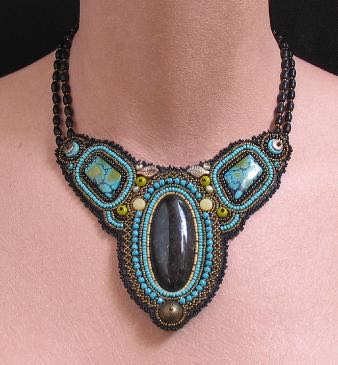
To Write a Book About My Art, I Had to Wear Two Hats
I was surprised and pleased when the publisher bought my first idea for a book. After that it was much work and a bit of worrying.
The creation of a design is quite a fun and exciting. The creation of a text book is another story—exciting to see it finished, but not always exciting to produce. I was challenged as a person to work hard and be exacting on myself with all the details.
Artists are generally not interested in writing about their work or showing someone else to how to do it. So it was necessary to put on two hats. One hat was the creative person who has to be experimental and reaching beyond the known to create a design that no one else has made. The other hat is exacting and precise and very specific with every word and action so that no reader is confused.
When the first book sold out the initial run of 10,000 I was ecstatic. Mainly it was verification that my creations were not only valuable, but they were understandable and wearable. The second and third books did very well too. I began to think of myself legitimately as an author!
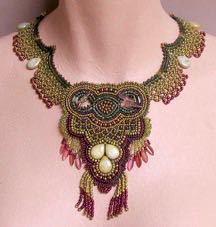
Writers: Listen to Your Serious Supporters
I did become more confident as a writer and designer. Nothing pumps you up like success! But I think the suggestions of others who said I was good and I should submit for publishing made a difference, so I would encourage the writer to listen to her serious supporters.
I am not lacking in self confidence, or so I’ve been told, but this was a new field and I think just being unafraid and putting my work out there let it happen. Of course it’s important to have done the leg work and got your ducks in a row.
I read a lot of other bead books and made other people’s designs before I tried writing my own. I checked out the field to see if my designs were already done by someone else. And I put together a sensible, practical and well organized proposal, following the publisher’s requested format.
I found the publisher and editors to be quite helpful. After all, they want to put out an excellent book as much as you. I even felt capable of fighting for a larger cut on the second and third books.

Books Don’t Necessarily Make You Famous
I learned that books don’t necessarily make you famous. Yes, you may get a lot of praise from some, but what the buyer wants is to make the jewelry.
I was able to demonstrate, teach classes and do a book signing at the annual Bead & Button Show in Milwaukee. I did a challenge from Japanese bead manufacturer Toho, and it traveled around the world with their show. I was able to meet and show and work with other bead and jewelry artists and to meet other designers that I admired myself.
I still get emails and messages in Facebook about the designs. Usually the questions are about what color or specific beads I used. I actually expected more personal responses, but I tell myself that if they bought the book and don’t write to me it’s because everything was great.
I have had some great reviews in Amazon and online. At the Bead & Button show I was interviewed on video for my publisher about the second book. This was perhaps the hardest as I was shy of the camera.
Ask Yourself: What if I Succeed?
It’s great fun to be an author. I know that my books are out there representing me and people are enjoying them.
Every bit of feedback is a pleasure. And even criticism means someone has read your book.
Don’t be afraid to try. Failing is just a step to success. I try to ask myself as I’m proposing something new: What if I succeed?
* * *
Virginia Jensen is a beadwork artist working in bead weaving and bead embroidery. Her accomplishments include three books of original beadwork designs with her own instructions and illustrations published by craft publisher Kalmbach Books, and she is currently working on a fourth book of two-hole bead designs.
The first book, Cube Bead Stitching, came out in 2009 and the second book, Contemporary Cube Bead Designs, came out in 2012. Both were about the new cube beads and designs to make with them.
The third book, Stitching With Two-Hole Shaped Beads, came out in 2015 and promotes the new two-hole beads sweeping the market. Each book has around 30 designs for beaders to make on their own with instruction in text and illustration.
Many of Virginia’s designs have appeared in the monthly beaders’ magazine, Bead & Button and her work has been featured in the German magazine Perlen Poesie. She teaches locally and has taught in the region as well as at the international Bead & Button Show in Milwaukee. Her work has traveled internationally in the Toho Bead Manufacturer Challenge.
For more information on Virginia and her work, please see her website or Amazon author page, or connect with her on Facebook.
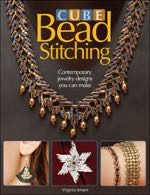 Cube Bead Stitching: Making jewelry with cube beads requires no special training or classes. This book explains it all. With clear instructions and hundreds of color photographs, expert Virginia Jensen shows how to make stunning jewelry using many of the most popular off-loom stitches.
Cube Bead Stitching: Making jewelry with cube beads requires no special training or classes. This book explains it all. With clear instructions and hundreds of color photographs, expert Virginia Jensen shows how to make stunning jewelry using many of the most popular off-loom stitches.
Chapters are divided by project type, including bracelets, earrings, necklaces, rings, and decorative items. Beginners learn the fundamentals of many popular stitches as they create the projects, while more experienced crafters enjoy the challenge of weaving an uncommon shape into a knockout piece.
Available at Amazon.
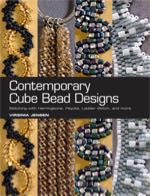 Contemporary Cube Bead Designs: Virginia Jensen offers more exciting ways to create with cube beads in her second book, Contemporary Cube Bead Designs. This book shows off versatile cube beads in a delightfully creative mix of necklaces, bracelets, and earrings.
Contemporary Cube Bead Designs: Virginia Jensen offers more exciting ways to create with cube beads in her second book, Contemporary Cube Bead Designs. This book shows off versatile cube beads in a delightfully creative mix of necklaces, bracelets, and earrings.
Virginia Jensen uses her artistic eye to develop subtle, fashion-forward color palettes, interesting patterns, and delightful shapes like stars and flowers. All 28 projects are fully illustrated – the best way to learn stitching techniques! Easy to find and fun to work with, cube beads offer a new range of possibilities for lovers of seed beads.
Available at Amazon.
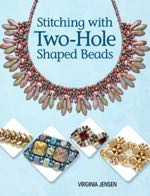 Stitching with Two-Hole Shaped Beads gives jewelry makers new ideas for using popular two-hole beads. Stitchers will learn how to use squares, Tilas, SuperDuos, rullas, bricks, disks, and more to create over 25 beautiful, geometric projects.
Stitching with Two-Hole Shaped Beads gives jewelry makers new ideas for using popular two-hole beads. Stitchers will learn how to use squares, Tilas, SuperDuos, rullas, bricks, disks, and more to create over 25 beautiful, geometric projects.
These gorgeous bracelets, earrings, and collars are made with five stitches including herringbone, peyote, square stitch, right-angle weave, and Virginia’s unique new stitch, the “cluster stitch.” As always, Virginia’s clear illustrations and instructions help all beaders understand and execute each piece with success.
Available at Amazon.


